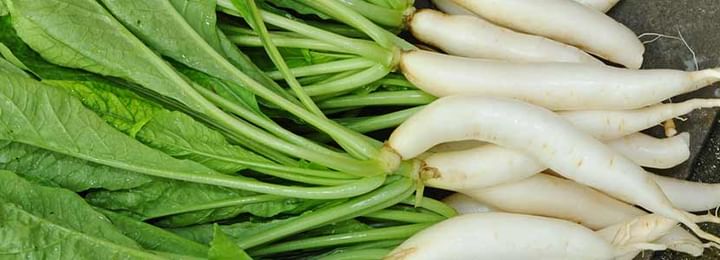Benefits of Radish Leaves And Its Side Effects
Last Updated: Aug 21, 2020
The health benefits of radish leaves are varied ranging from treating diabetes to rheumatism. It contains essential vitamins and minerals and it also acts as a detoxifying agent. The high iron and phosphorus content of radish leaves increases immunity and reduces fatigue. It also contains fibre that helps in digestive process.
Radish Leaves
Whenever it comes to radishes, we stop at the root and do not consider the leaves at all. Looking at the coarse, hairy and prickly texture of radish leaves, our inconsideration of them might seem justified but we miss out on the tons of nutrients that radish leaves possess.
They can used in a variety of ways in cooking; they can be sauteed with garlic and used as a side dish, they can be chopped up and used as toppings for soups, noodles and even in salads and sandwiches.
Nutritional Value of Radish Leaves
Radish leaves are rich in vitamins and minerals. It consists of iron, phosphorus, folic acid, calcium and vitamin C that are essential for many bodily functions. The presence of a variety of nutrients in radish leaves makes it a versatile herb that can cure and alleviate a variety of diseases.
Nutritional facts Per 1bundle 200g
Vitamins and Minerals
Health Benefits of Radish Leaves
Increases immunity and reduces fatigue
Fatigue, one of the most common ailment in modern times, can be effectively counteracted by consuming radish leaves. Along with high amount of iron and phosphorus, it also contains essential minerals like vitamin C , vitamin A and thiamine that help combat fatigue.
High amount of iron and phosphorus develops body's immunity. People suffering from anaemia and low haemoglobin can alleviate their conditions by ingesting radish leaves.
Radish leaves are naturally diuretic
Radish leaf juice is a natural diuretic. It has the ability to dissolve stones and clear the urinary bladder. It also has laxative properties so it can be used to ease constipation and a bloated stomach
Anti-scorbutic
Radish leaves help prevent scurvy. It is not surprising that it does because it contains a high amount of vitamin C.
Radish leaves can treat piles
Piles are very painful and radish leaves have properties that can help treat this painful condition. Owing to the antibacterial properties that they contain, radish leaves have also been seen to decrease swelling and inflammation. Powdered dry radish leaves mixed with equal amount of sugar and little bit of water can form a paste. This paste can either be consumed or applied topically on the inflammation.
Treats jaundice
Relieves rheumatism
Prevents diabetes
It is a detoxifying agent and also helps in digestive process
It is a detoxifying agent and also helps in digestive process. Our body gathers a lot of toxins and impurities on a daily basis and it is important to flush them out. Radish leaves contain a host of essential nutrients that has anti-microbial and anti-bacterial properties. These help in detoxifying the body and flushing out toxins.
Radish leaves are also high in dietary fibre that helps in the digestive process. It keeps uncomfortable conditions like constipation and bloated stomach in check.
Uses of Radish Leaves
Radish leaves can be sauteed with garlic and used as a side dish. It can also be blanched and used as topping on noodles. It can also be consumed raw in salads or as sandwich filling.
Allergies and Side-Effects of Radish Leaves
There is no such noted adverse effects of using radish leaves
Cultivation of Radish Leaves
There is no evidence as to where and when we started domesticating radish but wild variants of this vegetable started appearing in South East Asia. Other variants of radishes were also found in India, Central China and Central Asia. It was first recorded in writing in the 3rd century BC.
Ancient Greeks and Romans have also written about them. Upon the discovery of the Americas, radish was introduced there by Europe. Radish leaves do best in direct sunlight but they can also flourish in partly shaded areas. Radishes can be grown in any type of soil but the soil must contain a lot of humus.
References
- Kim BR, Park JH, Kim SH, Cho KJ, Chang MJ. Antihypertensive properties of dried radish leaves powder in spontaneously hypertensive rats. Korean Journal of Nutrition. 2010 Dec 1;43(6):561-9. [Cited 27 June 2019]. Available from:
- Ghayur MN, Gilani AH. α-adrenergic receptor mediated hypertensive and vasoconstrictor effects of dietary radish leaves extract. Journal of health science. 2007;53(2):151-5. [Cited 27 June 2019]. Available from:
- Urbonavičiūtė A, Samuolienė G, Brazaitytė A, Duchovskis P, Karklelienė R, Šliogerytė K, Žukauskas A. The effect of light quality on nutritional aspects of leafy radish. Sodininkystė ir daržininkystė. 2009;28(1):147-55. [Cited 27 June 2019]. Available from:
Table of content
Ask a free question
Get FREE multiple opinions from Doctors



